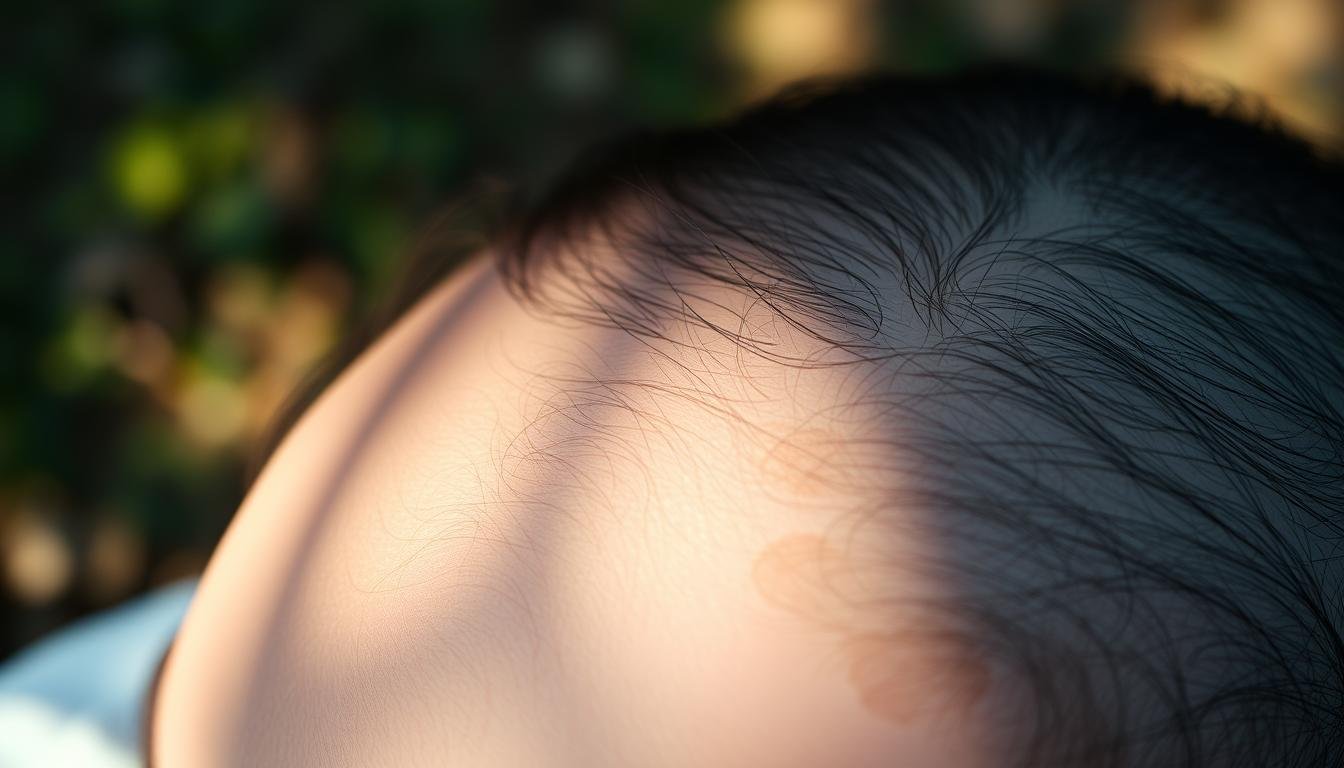What is Alopecia, and How to Treat it? | Hair Loss Guide
Did you know that alopecia, a hair loss condition, affects an astounding 6.8 million people in the United States alone? This widespread issue not only impacts physical appearance but can also take a significant toll on one’s mental well-being. As a comprehensive guide, we’ll delve into the various types of alopecia, their underlying causes, and the most effective medical and natural treatment options to help you regain your confidence and a healthy head of hair.
Key Takeaways
- Alopecia is a common Hair Loss condition affecting millions of Americans
- There are several different types of alopecia, each with its own causes and symptoms
- A combination of medical treatments and natural remedies can effectively manage Hair Loss
- Seeking professional help is crucial for proper diagnosis and personalized treatment plans
- Adopting a scalp-care routine and addressing lifestyle factors can help prevent or slow down hair loss
Understanding Alopecia: Definition and Types
Alopecia is a complex autoimmune disorder that leads to hair loss. It can manifest in various forms, each with its unique characteristics and triggers. One of the most common types is alopecia areata, which is characterized by the sudden appearance of circular, smooth patches of hair loss on the scalp or other body parts.
Alopecia Areata vs. Other Forms
While alopecia areata is the most prevalent form, there are several other types of alopecia that can affect individuals. These include:
- Alopecia totalis: Complete loss of hair on the scalp
- Alopecia universalis: Complete loss of hair on the entire body
- Traction alopecia: Hair loss caused by constant pulling or tension on the hair
- Scarring alopecia: Permanent hair loss due to underlying skin conditions or injuries
Common Triggers and Risk Factors
The exact Cause of alopecia is not fully understood, but it is believed to be triggered by a combination of genetic and environmental factors. Some common triggers and risk factors for alopecia include:
- Stress and anxiety
- Autoimmune disorders
- Family history of alopecia
- Certain medical conditions, such as thyroid disorders
- Trauma or physical Stress to the hair and scalp
Signs and Symptoms to Watch For
The primary symptom of alopecia is the loss of hair, which can occur in different patterns and at varying rates. Some of the common signs and symptoms include:
- Smooth, circular bald patches on the scalp
- Thinning or patchy hair in other areas of the body
- Increased shedding of hair during brushing or washing
- Itching, redness, or inflammation of the scalp
It’s important to consult a trichologist or dermatologist if you suspect you may be experiencing any form of alopecia. Early diagnosis and proper treatment can help manage the condition and potentially regrow lost hair.

The Science Behind Hair Loss and Autoimmune Response
When it comes to hair loss, particularly in the case of autoimmune-related alopecia, the underlying science is both fascinating and complex. At the heart of this condition is the immune system’s misguided attack on the body’s own hair follicles, leading to the premature loss of hair. This autoimmune disorder is believed to be influenced by a combination of genetic predisposition and environmental factors.
The immune system, which is typically designed to protect the body from foreign invaders, mistakenly identifies the hair follicles as a threat in individuals with alopecia. This triggers an inflammatory response, where specialized immune cells, such as T cells, infiltrate the follicles and disrupt their normal function. As a result, the hair growth cycle is disrupted, leading to the gradual thinning and eventual loss of hair.
Genetics play a crucial role in the development of autoimmune disorders like alopecia. Certain genetic variations and mutations can make an individual more susceptible to this condition, as they may alter the way the immune system recognizes and responds to the hair follicles. Additionally, environmental factors, such as stress, infections, or exposure to certain chemicals, can also trigger or exacerbate the autoimmune response, contributing to the onset and progression of hair loss.
| Immune System Mechanism | Impact on Hair Follicles | Potential Triggers |
|---|---|---|
| Autoimmune attack on hair follicles | Disruption of normal hair growth cycle | Genetic predisposition, stress, infections, environmental factors |
Understanding the science behind autoimmune-related hair loss is crucial for developing effective treatments and management strategies. By gaining insights into the underlying mechanisms and potential triggers, healthcare professionals can tailor their approach to address the root causes of this condition and provide patients with the best possible care.

“The immune system’s misguided attack on hair follicles is the driving force behind autoimmune-related alopecia.”
What is Alopecia, and How to Treat it?
Alopecia is a medical condition characterized by hair loss, affecting both men and women. Understanding the diagnosis process, its impact on physical and mental well-being, and when to seek professional help are crucial for effectively managing this condition.
Medical Diagnosis Process
The diagnosis of alopecia typically involves a thorough examination by a dermatologist or trichologist, a specialized healthcare provider focused on hair and scalp disorders. They will assess the pattern and extent of hair loss, perform necessary tests, and determine the underlying Cause, whether it’s alopecia areata, androgenetic alopecia, or another form of the condition.
Impact on Physical and Mental Health
Hair loss can have a significant impact on an individual’s physical and mental health. Alopecia can lead to self-consciousness, social anxiety, and even depression. Additionally, the physical changes associated with hair loss can affect one’s self-esteem and quality of life.
When to Seek Professional Help
It is crucial to seek the advice of a dermatologist or trichologist if you experience any signs of hair loss, such as excessive shedding, bald patches, or thinning of hair. These professionals can provide a proper diagnosis, recommend appropriate alopecia treatment options, and develop a personalized management plan to address the underlying causes and alleviate the impact on your overall well-being.
By understanding the medical diagnosis process, the importance of addressing the physical and mental health implications, and the benefits of seeking professional help, individuals can take the necessary steps to effectively manage hair loss remedies and alopecia treatment options, ultimately improving their dermatology and trichology outcomes.

“Early diagnosis and intervention are key to managing alopecia and maintaining a healthy head of hair.”
Conventional Medical Treatments for Alopecia
When it comes to managing alopecia, the conventional medical approach often involves a range of treatments aimed at addressing the underlying causes and promoting hair regrowth. These therapies, prescribed by dermatologists and other healthcare professionals, can be highly effective in managing various types of hair loss, including alopecia areata, androgenetic alopecia, and other forms of baldness.
Topical Medications
One of the most common conventional treatments for alopecia is the use of topical medications. These include corticosteroids, such as minoxidil (Rogaine) and anthralin, which can help stimulate hair growth and reduce inflammation. These solutions are typically applied directly to the affected areas of the scalp, often on a daily basis, to achieve the desired results.
Oral Medications
In some cases, healthcare providers may prescribe oral medications to treat alopecia. These can include immunosuppressant drugs like methotrexate or cyclosporine, which work to modulate the immune system and reduce the autoimmune response that can lead to hair loss. Additionally, biotin and other vitamin supplements may be recommended to support healthy hair growth.
Corticosteroid Injections
For more localized or severe cases of alopecia areata, dermatologists may administer corticosteroid injections directly into the affected areas of the scalp. These injections can help suppress the immune system’s attack on hair follicles, allowing for the regrowth of lost hair.
| Conventional Alopecia Treatments | Potential Benefits | Potential Drawbacks |
|---|---|---|
| Topical Medications | – Stimulate hair growth – Reduce inflammation |
– Requires daily application – May cause skin irritation |
| Oral Medications | – Modulate immune system – Support healthy hair growth |
– Potential side effects – Require ongoing prescription |
| Corticosteroid Injections | – Suppress immune response – Promote hair regrowth |
– Temporary solution – Require regular visits |
It’s important to note that the effectiveness of these conventional medical treatments for alopecia can vary depending on the individual and the type of hair loss they are experiencing. Regular communication with a dermatologist or healthcare professional is crucial to develop a personalized treatment plan that addresses the specific needs and concerns of the patient.

Natural and Alternative remedies for Hair Loss
When it comes to managing hair loss, many individuals are seeking natural and alternative solutions that complement or supplement conventional medical treatments. These holistic approaches often focus on improving scalp health, promoting hair growth, and addressing the underlying causes of hair shedding, such as stress and nutritional deficiencies.
Dietary Changes and Supplements
Incorporating certain dietary changes and supplements can support healthy hair growth. Some recommended strategies include:
- Increasing the intake of protein-rich foods, such as lean meats, eggs, and legumes, to provide the building blocks for hair follicles.
- Consuming foods rich in essential vitamins and minerals, like iron, zinc, and biotin, which are crucial for proper hair development.
- Supplementing with hair-specific formulas that contain a blend of nutrients, including vitamins, minerals, and herbs, to address potential deficiencies.
Lifestyle Modifications
Adopting a few lifestyle changes can also contribute to improved scalp health and hair growth:
- Reducing stress levels through relaxation techniques, such as meditation, yoga, or deep breathing exercises.
- Avoiding excessive use of heat-styling tools and harsh hair products, which can damage the hair and scalp.
- Incorporating gentle scalp massages to improve blood circulation and nutrient delivery to the hair follicles.
Stress Management Techniques
Stress is a well-known trigger for various types of hair loss, including alopecia areata. Implementing effective stress management strategies can help mitigate the negative impact of stress on hair health:
| Technique | Description |
|---|---|
| Meditation | Regular practice of mindfulness or guided meditation can help reduce stress and anxiety levels. |
| Exercise | Physical activity, such as yoga, Tai Chi, or aerobic exercise, can release endorphins and improve overall well-being. |
| Cognitive Behavioral Therapy (CBT) | CBT can help identify and reshape negative thought patterns, promoting a more positive mindset. |
By incorporating a combination of dietary changes, lifestyle modifications, and stress management techniques, individuals can take a more holistic approach to addressing hair loss and promoting scalp health.

Latest Advancements in Alopecia Treatment
In the field of alopecia treatment and hair loss remedies, researchers and medical experts have made remarkable strides in recent years. From innovative medications to cutting-edge regenerative approaches, the landscape of dermatology and trichology is rapidly evolving, offering new hope for those affected by this challenging condition.
One of the most promising developments is the approval of several new alopecia treatment drugs that target the underlying autoimmune response. These medications, such as Janus kinase (JAK) inhibitors, have demonstrated impressive results in clinical trials, helping to stimulate hair regrowth and reduce the severity of symptoms.
Alongside pharmacological advancements, researchers are also exploring the potential of regenerative medicine in hair loss remedies. Stem cell-based therapies and tissue engineering techniques hold the promise of restoring damaged hair follicles, paving the way for more natural and long-lasting solutions.
Furthermore, the integration of digital technologies in dermatology and trichology has revolutionized the way patients receive care. Teledermatology and AI-powered diagnostic tools are enabling earlier detection and more personalized treatment plans, empowering individuals to take a proactive approach to their hair health.
“The future of alopecia treatment is truly exciting, with the potential to transform the lives of those affected by this condition. As we continue to push the boundaries of medical science, I am confident that we will see even more remarkable breakthroughs in the years to come.”
– Dr. Emily Wilkins, Renowned Dermatologist and Trichologist
With these advancements, individuals suffering from alopecia and other forms of hair loss can now look to the future with renewed hope and optimism, as the medical community works tirelessly to provide innovative and effective hair loss remedies.

Prevention Strategies and Scalp Care
Maintaining healthy scalp and preventing hair loss requires a comprehensive approach. By adopting a proactive hair care routine and incorporating protective measures, you can effectively manage your scalp health and reduce the risk of hair loss.
Daily Hair Care Routine
A well-structured daily hair care routine is the foundation for scalp and hair health. This includes:
- Gentle shampooing to cleanse the scalp without stripping natural oils
- Conditioning to nourish and strengthen hair strands
- Incorporating a scalp massage with fingertips to stimulate blood flow
- Limiting the use of hot styling tools to prevent damage
- Protecting hair from sun exposure with hats or scarves
Protective Measures and Best Practices
In addition to a daily hair care routine, there are several protective measures and best practices that can help maintain scalp health and prevent hair loss:
- Minimize stress through relaxation techniques, such as yoga or meditation, as stress can contribute to hair loss
- Eat a balanced, nutrient-rich diet that supports hair growth, including foods rich in vitamins, minerals, and proteins
- Avoid harsh chemicals and treatments, such as harsh dyes or perms, that can damage the scalp and hair
- Regularly see a trichologist or dermatologist for professional evaluation and personalized hair care recommendations
By implementing these prevention strategies and adopting a proactive approach to scalp care, you can take meaningful steps towards maintaining healthy, vibrant hair and minimizing the risk of hair loss.

| Prevention Strategies | Benefits |
|---|---|
| Gentle hair care routine | Cleansing, nourishing, and stimulating the scalp |
| Stress management | Reducing the impact of stress on hair and scalp |
| Balanced, nutrient-rich diet | Providing the necessary nutrients for healthy hair growth |
| Avoiding harsh treatments | Preventing damage and irritation to the scalp |
| Regular professional evaluation | Receiving personalized recommendations for optimal scalp and hair health |
By incorporating these prevention strategies and scalp care best practices into your daily routine, you can take proactive steps towards maintaining healthy, vibrant hair and reducing the risk of hair loss.
Living with Alopecia: Coping Strategies and Support
Navigating life with alopecia areata, a condition that causes unpredictable hair loss, can be a significant challenge. However, with the right support groups and coping mechanisms, individuals living with alopecia can learn to embrace their unique journey and prioritize their mental health.
One of the most important steps in managing alopecia is to build a strong support network. Joining local or online support groups can provide a safe space for individuals to connect with others who understand the emotional and practical aspects of living with hair loss. These groups offer a platform for sharing experiences, accessing educational resources, and finding solidarity during difficult times.
In addition to seeking support from others, individuals with alopecia can also explore various coping strategies to build self-confidence and resilience. This may include practicing self-care routines, such as engaging in stress-relieving activities, maintaining a healthy lifestyle, and exploring alternative hair solutions that align with personal preferences.
It’s crucial for those living with alopecia to prioritize their mental health and seek professional help when needed. Therapists and counselors can provide valuable guidance on navigating the emotional aspects of hair loss, offering techniques for managing anxiety, depression, and feelings of isolation.
“The journey with alopecia is not an easy one, but with the right support and coping mechanisms, individuals can learn to embrace their unique beauty and find strength in their resilience.”
By fostering a supportive environment, practicing self-care, and prioritizing mental well-being, individuals with alopecia can navigate their condition with greater confidence and find their path to personal growth and acceptance.

| Coping Strategies for Alopecia | Benefits |
|---|---|
| Joining Support Groups | Connects individuals with a community that understands their experiences and provides emotional support |
| Practicing Self-Care Routines | Helps manage stress, boost mood, and maintain a sense of control during hair loss |
| Seeking Professional Mental Health Support | Provides guidance and techniques for managing the emotional challenges of alopecia |
Expert Tips for Managing Different Types of Hair Loss
Navigating the complexities of hair loss can be daunting, but with the guidance of experienced professionals, finding the right treatment approach is attainable. Dermatologists and trichologists, experts in the field of skin and hair disorders, offer invaluable insights into managing various forms of alopecia.
Professional Treatment Options
For individuals struggling with alopecia areata, an autoimmune condition that causes patchy hair loss, intralesional corticosteroid injections administered by a dermatologist can be highly effective in stimulating regrowth. In cases of androgenetic alopecia, or female/male pattern baldness, FDA-approved medications like minoxidil and finasteride, prescribed by a healthcare provider, can help slow down or even reverse the progression of hair loss.
Long-term Management Plans
While there is no one-size-fits-all solution for alopecia, a comprehensive management plan tailored to the individual’s needs is crucial for long-term success. This may include a combination of medical treatments, lifestyle modifications, and ongoing monitoring by a trichologist or dermatologist. Regular scalp assessments, personalized hair care regimens, and addressing any underlying medical conditions can contribute to the effective management of different types of hair loss.
FAQ
What is alopecia?
Alopecia is a general term used to describe hair loss or baldness. It can occur due to various reasons, including autoimmune disorders, hormonal imbalances, stress, and certain medical conditions.
what are the different types of alopecia?
The most common types of alopecia include alopecia areata, androgenetic alopecia (male/female pattern baldness), and traction alopecia. Other forms include alopecia totalis, alopecia universalis, and scarring alopecia.
What causes alopecia?
Alopecia can be caused by a variety of factors, including autoimmune disorders, genetics, hormonal imbalances, stress, certain medications, and medical conditions such as thyroid disorders or anemia.
what are the symptoms of alopecia?
The primary symptom of alopecia is hair loss, which can occur in small, localized patches (alopecia areata) or more extensive areas of the scalp or body. Itching, redness, and inflammation of the scalp may also be present.
How is alopecia diagnosed?
Alopecia is typically diagnosed through a physical examination, medical history review, and sometimes scalp biopsy or blood tests to rule out underlying medical conditions.
What are the treatment options for alopecia?
Treatment options for alopecia include topical or oral medications, corticosteroid injections, light therapy, and in some cases, hair transplantation or other surgical procedures. Natural remedies, such as dietary changes, supplements, and stress management, may also be beneficial.
How can alopecia affect mental health?
Alopecia can have a significant impact on a person’s mental and emotional well-being, leading to issues such as low self-esteem, anxiety, depression, and social withdrawal. Seeking support and counseling can be crucial for managing the psychological effects of hair loss.
When should someone seek professional help for hair loss?
It’s recommended to consult a dermatologist or trichologist (hair and scalp specialist) if you experience sudden, excessive, or persistent hair loss, as they can help diagnose the underlying cause and develop an effective treatment plan.
What are some natural remedies for hair loss?
Natural remedies for hair loss may include dietary changes to improve nutrient intake, supplements containing vitamins, minerals, and herbs, scalp massages, and stress management techniques, such as meditation or yoga.






